Backlinks are the #1 off-site ranking factor that affects your search engine placement on Google. While you do not have direct control over links from other websites, you can do some sneaky SEO research to analyze competitors.
The most important thing to remember when you’re trying to build backlinks is that you can easily overdo it. In general, if you are creating your own links then you may already be venturing into greyhat or blackhat search engine optimization territory.
Natural, organic creation of links is the best way to go. It does take longer this way, but it’s necessary to achieve results that last long-term. There are some tips and strategies you can put into action that will help to speed up this process while sticking to whitehat techniques.
This guide is going to teach you how to perform analysis on your website competition to find out where they got their links. You can then use this information to benefit your own site.
Why do Backlinks Matter?
The internet is a collection of independent websites, but almost all of them are interconnected by a web of links. These connections from one website to another actually provide some structure and organization to millions of sites.
You probably won’t find a site about side hustles and marketing like the Side Bacon Blog that has a link to a site about dogs, as you likely won’t find one about dogs linking up to one that has a focus on marketing. There can be some random exceptions but most will link to relevant topics.
Search engines like Google index all of those connections. They can then map out that web to determine some important information:
- What websites are the most important or authority sites with a lot of backlinks from other important sites?
- What kind of content and keywords can be found on the connected sites and pages?
- How does everything fit together with these connections in place?
This is NOT a numbers game.
Having 100 links can be better than 10,000.
What really matters is link quality. Quality is determined by the web of connections and by content found on those sites.
Consider two different sites: one is a brand new domain name just registered yesterday with 5 pages of content and no inbound links, while the second site is Wikipedia.com, a 21 year old site, with potentially millions of pages of content and countless inbound links.
There simply isn’t a comparison between the strength of a backlink from those two websites.
It could easily take thousands of links from new websites to even come close to being equal to a single link from Wikipedia.
Google and other search engines will take account for all of this data in their ranking algorithm.
For your own website, this matters because you need to focus on trying to gain backlinks from high-quality and relevant sites that could be viewed as an authority for your niche. Just a handful of links from them will catapult yours to the top of the search rankings.
Buying & Exchanging Links
Most beginners will instantly consider trading with relevant websites or even buying links outright.
You MUST AVOID paying for links. This is specifically prohibited in the best practices and search policies of all major engines.
The same can be said for link exchanges. They do not represent a natural and organic process of link creation, so they’re also frowned upon.
Using these types of tactics can actually result in your site receiving penalties in search rankings that make it next to impossible to receive traffic.
Ultimately, anything that gets forced in this manner isn’t considered natural and could cause you more harm than good.
There are technically some ways around these rules, but I really don’t consider the potential rewards to be worth the risk.
A search engine will take notice when links seem abnormal or when they’re blatantly advertised as being for sale. Privately contacting a site to arrange a deal for a permanent link could stay under the radar, but you have to exercise extreme caution if you take this approach.
You don’t want to buy links from a site that will sell them to more than one person or else they’ll start looking like a link farm.
I really recommend avoiding link exchanges entirely. There is a way to solicit a high-quality backlink from another website that I’ll be discussing later in this training guide.
Competitor Analysis Research
The easiest way to analyze your competition is to use a free backlink checker tool on AHREFs.
This site will tell you a lot of useful information for any domain name or URL address including a list of other sites that have provided an inbound link.
You can use this research to find companies and people to contact to attempt to get a link for your own site.
Start your research on Google. Search keywords here to find your competition.
I have a new article that teaches how to build and grow an email newsletter list. It’s a long-form SEO article that is excellent to use for reference for your own content creation. I’ll use it here as a brief example for how to perform competitor backlink analysis.
If I want to try to get a top 10 ranking for the keyword phrase “email marketing training”, I’d start with a Google search to find the sites that already have a top 10 ranking.

This search reveals that a page on hubspot.com has the top ranking. Once you get to know the top authority sites on the internet, you’ll realize why this instantly tells me the competition is likely too high to get a decent ranking on this phrase. However, I’ll still carry out the research to show you how this works.
With your own site, make sure you target keywords that have a less powerful site as the #1 ranking and throughout the rest of the top 10 spots.
I’m going to click on the Google result to visit the page so I can copy the full URL of that page.
Then I will take that URL to the AHREFs Backlink Checker (linked above):
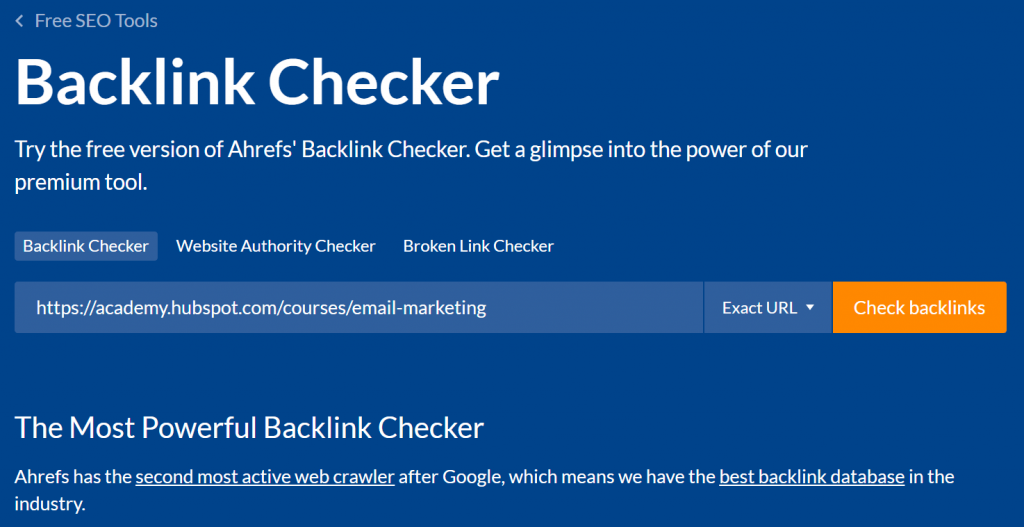
The scan that runs will take a minute or two. Be patient. It’s worth it.
When the scan is complete, you’ll get a backlink profile report like the one below:
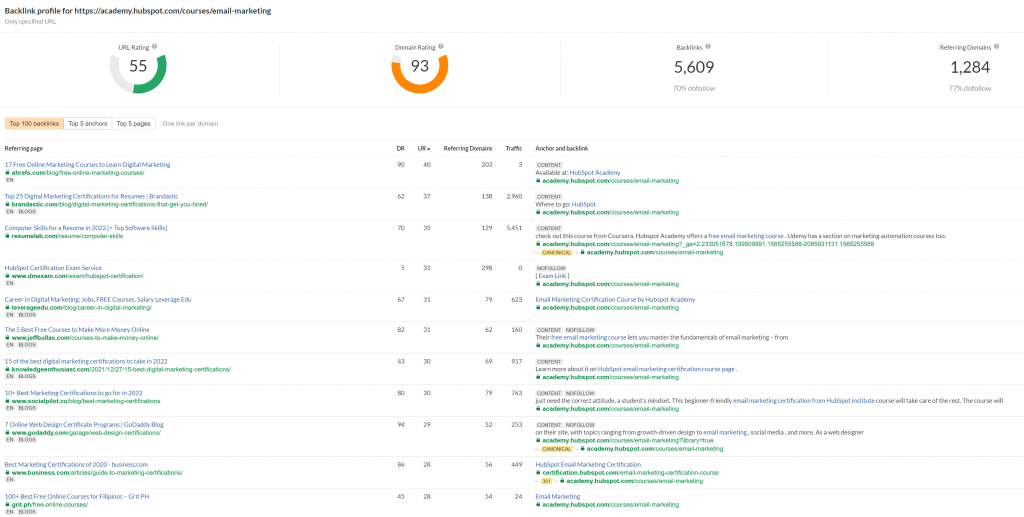
At the top of the backlink profile you can see three important pieces of information:
- URL Rating – Backlink power for the searched URL page. Higher numbers are stronger.
- Domain Rating – Backlink power for the base domain name for the searched URL.
- Backlinks – How many total inbound links this page has from external websites and internal pages.
I mentioned earlier that this domain had a lot authority and would be very difficult to beat in the search rankings. The Domain Rating of 91 confirms that suspicion for me.
The URL Rating is a bit more encouraging, although still a high number. A lot of URL Ratings can be less than 30, so 55 is still a lot of competition. Technically possible to beat if you can make an authority page about email marketing training, but it would take a lot of work.
You’ll see a list of URLs on this report. Each of them is a page that contains a link to the URL you searched on AHREFs.
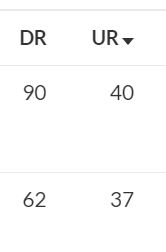
Two of the columns in this list, UR and DR, are URL and Domain Ratings for each of the linking pages.
If you’re able to get a backlink from one of these sites, it most likely will not be from the specific URL being listed, so pay more attention to the DR column in this list.
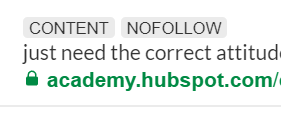
Under the anchor and backlink column, keep an eye out for any URLs that show the “NOFOLLOW” tag.
Getting a link from those sites will most likely not benefit your rankings, so don’t waste your time.
NoFollow means that the site has told search engines not to index their backlinks.
How do you take this list and use it to get links for your site?
I’ll show you my process below.
Ultimately, I’m looking for a few things on each site that I investigate:
- Author Details
- Contact Information
- Guest Posting Opportunities
After clicking on the top backlink, I arrive at the page below:
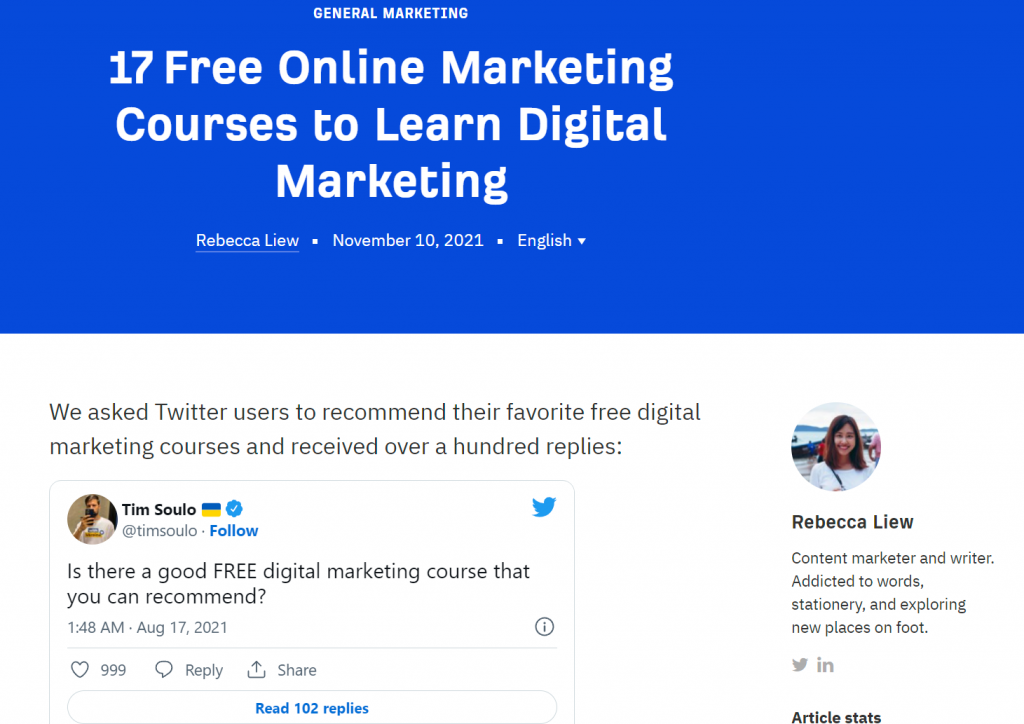
First I want to try to figure out how the backlink was gained.
Did the author think it was a good resource to use as a reference or is the author the owner of the site that received the backlink?
Sometimes you’ll be able to figure out that you can create your own account on that website to post your own article.
If you can’t post your own content there, start to look for contact information. This can be contact details for the entire website, but it can sometimes be helpful to directly contact the article author.
Navigating to the author profile for this article shows me LinkedIn and Twitter profiles that I could use to try to contact. Perhaps you have an amazing article that would be a good resource for them to add, so you contact them to let them know about it or see if they would do a new article about your post.

If you’re not able to find a way to contact the author directly, you can use the main contact option on the website.
Guest Blogging
One of the best things that you can find on a site that you’re researching is an opportunity to be a guest blogger. A lot of popular blogs are some of the best backlinks you can get, and many of them will allow you to write and contribute your own content.
Make sure you search around the site to find a page for guest blogging, contributing content, or something like “Write for Us” as seen below (this one was found in the footer at the bottom of the home page):

If you find one of these opportunities, take it seriously.
This is NOT a quick scheme to gain a backlink. If you approach it that way, you probably won’t get your content published.
Guest blogging is your chance to shine, so you want to write the best possible article that you can for a topic that relates to your site.
By providing a high-quality, in-depth article, you’ll be much more likely to get it published to gain your backlink. Once you get published, better articles will simply get more attention and bring you more direct traffic.
Guest Podcasts
A variation of guest blogging uses podcasting instead. Podcasts need constant guests on their shows. Many of them also run a website where they publish each new episode recording after the live show.
First try to find some podcasts that relate to your niche. Visit their website to see if they publish recordings, and take special note of whether they give a backlink to the guest of each show.
When you find a podcast that does provide a link, simply contact them to apply as a guest on their show.
Blackhat SEO Warnings
I need to emphasize one more time that you really need to avoid link building schemes and other blackhat SEO link building strategies. It simply isn’t worth the risk. Once your site gets penalized for violating backlinking rules, you may never be able to recover from it.
Take the time to utilize AHREFs backlink checker to seek out as many inbound links as possible. However, don’t force it all to happen at once. This needs to be natural and happen slowly over time.
Once you’ve exhausted your potential resources, the last thing to do is simply wait. As long as you have some search rankings and website traffic, other website owners will eventually find your content. If you have focused on writing high-quality content that is useful, it will naturally gain backlinks over time as people discover it.
This ultimately means that the real secret to build inbound links is to focus on your content and don’t worry about linking because it will happen on its own.
